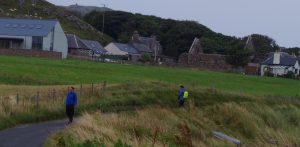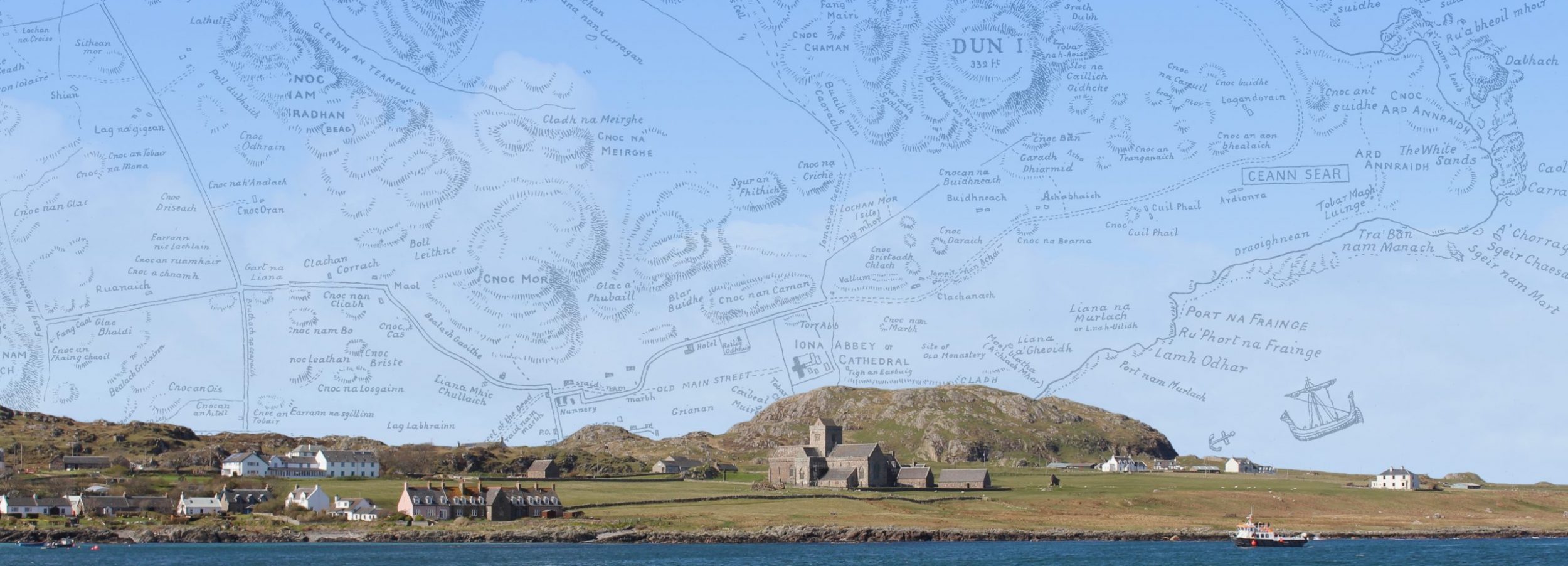An Eala: further evidence of the medieval ritual landscape
One of the things that I was pleased to have a closer look at, when my colleagues and I visited Iona a few weeks ago, was An Eala. It is now just a small grassy hump on the west side of the road running south from Am Baile Mòr, something you would hardly notice as you were walking past. Here is Katherine Forsyth (on the right) inspecting it.

The name is discussed in the Ordnance Survey Name Book in the mid-nineteenth century, where it is described:
A small hillock at Port nam Mairtir on which the coffins were set after being taken from the boat, and while the funeral processions were being arranged for Relig Oran. A street led from this point to St Oran’s Chapel. Meaning: “The Swan.”[1]
This short passage is probably quite accurate in its account of this being the place for landing the bodies of the dead, which were brought to Iona for burial and landed on the shore just below An Eala. But it is not only a convenient place where a body would be laid before its final journey to the grave. It was a focus of ritual activity as well. First of all, it was itself a place of burial. Excavation of the mound revealed dozens of burials, most of which appear to have been of women, and it was found that:
of the eight females whose skeletal remains permitted a determination to be made, none had borne children. It was also noted that neither men [there were some, evidently] nor women exhibited evidence of the hard manual labour to be expected among a peasant community, and none had died by violence. From these conclusions the burials may tentatively be associated with a community of celibate females, perhaps the local convent of Augustinian nuns.[2]
In addition to being a special burial place, other rituals were carried out here. Reeves records a tradition that ‘funeral parties on landing were formerly in the habit of laying the remains upon this mound, while they thrice performed a deisiol, or right-wise circuit, round the spot.’[3] This circling was a way of honouring and blessing a person or a place. Should we understand it as a gesture of prayer for the dead person lying on top of An Eala, or perhaps a way of honouring some of the holy dead whose bodies were buried beneath? Or perhaps both, so that the honouring of the buried ones acted as a prayer for the person about to be buried.
And what of the name? An Eala, at first sight, is simply Gaelic for ‘the swan’. That is how the name was understood in the late eighteenth century, at least. In 1776 Lieutenant Allan MacDonald of Knock, then on board a ship in Canada, entered into his little notebook a description of Iona which seems to have come from the island’s schoolteacher. Among his notes he remarks, ‘There are several small Ports, one called Martyr’s Port, where all the Bodies to be interred were landed – The Corps were laid on a Rock called the Swan.’[4] He expressed no curiosity about the origin of the name, nor why this mound should have been named in this way.
The appearance of the modern form of the name is deceptive, however. It has nothing to do with a ‘swan’ (Gaelic eala), nor is it a reduced form of ealatrom ‘a coffin’, as William Reeves believed.[5] It represents a form of the Gaelic word ailad ‘tomb, sepulchre, burial cairn’. This word takes on a bewildering variety of forms in Gaelic literature: aulad, ilad, elad, ulad, ilaidh, elaith, ulaidh, ulaid, hullta, ailaidh, elaid, ulaid, aulaid, iolaidh, ilaidh, uladha, uladh, ulltaib, ula, ila, ulaidh, uladh, ultha and, as here on Iona, eala.[6]
Such cairns and burial monuments are important ritual objects in ancient monastic landscapes. Sometimes they are just piles of rocks, at other times they are rather more deliberately erected altar-like constructions. And this may have been at some stage what was at An Eala. Alexander Carmichael, the great collector of popular Gaelic verse and charms, wrote of this place ‘there is a raised platform called eala. The platform is in the form of an altar, and the dead were carried three times sunwise around it, and placed upon it before burial.’ Had he seen it himself, or was he relying on the report of someone else – perhaps someone a good deal earlier?[7]
The Eala certainly does seem to be known as early as the sixteenth century, as it seems to be the monument referred to in Manus O’Donnell’s Life of Columba. In this Life, composed in Ireland around 1510, Columba and his monks have gone from the monastery down to the shore to pray. While they are there a boat lands in the bay (presumably Martyrs’ Bay) whose sailors are bringing an old man who is close to death. Columba instructed the old man in the Gospel and baptised him, and he died and was buried there. ‘And the monks who were with Colum Cille at that time made an ula in that place, in memory of that event, and it remains there ever since.’[8] O’Donnell’s ula is surely our Eala. Certainly in O’Donnell’s mind it is more than a mere grassy hump; it is something that needed to be ‘made’. And his use of the word elsewhere in his Life of Columba suggests that he might see an ula as something like a stone altar – interestingly the kind of monument that I proposed a few weeks ago in a blog as having perhaps once stood on Cnoc Angel. Maybe here at An Eala, like Cnoc Angel, there was once a gathering-place, monumentalised in stone by the monks, which served as another articulation of the sacred space and devout movement that shaped the landscape of Iona.
[1] Ordnance Survey Name Book, 37.26).
[2] https://canmore.org.uk/site/21641/iona-an-eala
[3] William Reeves, The Life of St Columba, founder of Hy (Dublin, 1857), 423.
[4] NLS MS 14876, 87 (folio 42 r.).
[5] Reeves, ibid. This word derives ultimately from Latin feretrum ‘bier’.
[6] Dictionary of the Irish Language, s.v. ailad. A secondary meaning is given as ‘a penitential station’.
[7] Alexander Carmichael, Carmina Gadelica: Hymns and Incantations, volume II (dinburgh, 1828), 278-9.
[8] A. O’Kelleher and G. Schoepperle (eds), Betha Colaim Cille, Life of Colum Cille, (Urbana, Illinois, 1918), 262 (my translation).
